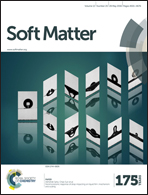Self-organization of hydrophobic-capped triblock copolymers with a polyelectrolyte midblock: a coarse-grained molecular dynamics simulation study
Abstract
We present the results of a Langevin dynamics simulation study of micellar organization and hydrogel formation in the solutions of coarse-grained ABA copolymer chains. Polymer chains are modeled as bead–spring chains of Lennard-Jones particles by explicit treatment of ionic species in implicit solvent. The studied copolymer is composed of a polyelectrolyte midblock flanked by two hydrophobic endblocks. We explore the self-assembly of copolymer solutions at a fixed polymer concentration and temperature upon systematic variation of the midblock charge fraction, valency of neutralizing counterions, and the stiffness and length of hydrophobic endblocks. Minimization of the surface energy, conformational entropy of the midblock chains, electrostatic repulsion of midblock charges, and the translational entropy of counterions are found to play central roles in controlling the self-organization features of copolymer solutions. Flower-like micelles with A-blocks forming the core of spherical aggregates and B-blocks constituting the micelle corona are established for the neutral midblocks. Increasing the charge content of B chains lowers the fraction of loop conformations and yields a spanning hydrogel network with midblocks bridging the hydrophobic clusters. Counterion valence is shown to exert a strong effect on the micelle size and network structure. The increase in the rigidity of terminal A-blocks increases the fraction of bridging chains and results in the formation of a hydrogel network with bundle-like hydrophobic domains. Longer endblocks are shown to increase the hydrophobic cluster size and enhance the bridged midblock fraction. The qualitative agreement between the experimental and theoretical studies is also discussed. The comprehensive molecular picture provides a framework for the future studies of stimuli-responsive copolymer systems.


 Please wait while we load your content...
Please wait while we load your content...